Related Research Articles

The tiger is the largest living cat species and a member of the genus Panthera. It is most recognisable for its black stripes on orange fur with a white underside. An apex predator, it primarily preys on ungulates, such as deer and wild boar. It is territorial and generally a solitary but social predator, requiring large contiguous areas of habitat to support its requirements for prey and rearing of its offspring. Tiger cubs stay with their mother for about two years and then become independent, leaving their mother's home range to establish their own.

The clouded leopard, also called mainland clouded leopard, is a wild cat inhabiting dense forests from the foothills of the Himalayas through Northeast India and Bhutan to mainland Southeast Asia into South China. It was first described in 1821 on the basis of a skin of an individual from China. The clouded leopard has large dusky-grey blotches and irregular spots and stripes reminiscent of clouds. Its head-and-body length ranges from 68.6 to 108 cm with a 61 to 91 cm long tail. It uses its tail for balancing when moving in trees and is able to climb down vertical tree trunks head first. It rests in trees during the day and hunts by night on the forest floor.

The North Sulawesi babirusa is a pig-like animal native to Sulawesi and some nearby islands in Indonesia. It has two pairs of large tusks composed of enlarged canine teeth. The upper canines penetrate the top of the snout, curving back toward the forehead. The North Sulawesi babirusa is threatened from hunting and deforestation.
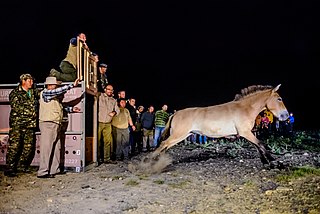
Species reintroduction is the deliberate release of a species into the wild, from captivity or other areas where the organism is capable of survival. The goal of species reintroduction is to establish a healthy, genetically diverse, self-sustaining population to an area where it has been extirpated, or to augment an existing population. Species that may be eligible for reintroduction are typically threatened or endangered in the wild. However, reintroduction of a species can also be for pest control; for example, wolves being reintroduced to a wild area to curb an overpopulation of deer. Because reintroduction may involve returning native species to localities where they had been extirpated, some prefer the term "reestablishment".
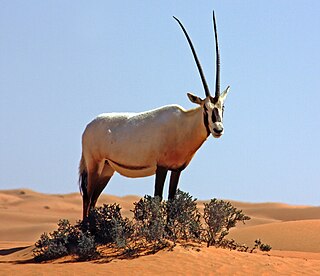
The Arabian oryx or white oryx is a medium-sized antelope with a distinct shoulder bump, long, straight horns, and a tufted tail. It is a bovid, and the smallest member of the genus Oryx, native to desert and steppe areas of the Arabian Peninsula. The Arabian oryx was extinct in the wild by the early 1970s, but was saved in zoos and private reserves, and was reintroduced into the wild starting in 1980.

The Ilin Island cloudrunner is a cloud rat known from a single specimen purchased on Ilin Island in the Philippines. It is called siyang by the Taubuwid Mangyan. It is a fluffy-coated, bushy-tailed rat and may have emerged from tree hollows at night to feed on fruits and leaves. The specimen, collected on 4 April 1953, was presented to the National Museum of Natural History in Washington D.C. The island's forests have been destroyed by human activity. The cloudrunner is among the 25 “most wanted lost” species that are the focus of Re:wild’s “Search for Lost Species” initiative. As there in no proof that the single specimen originated on Ilin Island, searches are now focussed on nearby Mindoro. Hope that it may be rediscovered have prompted IUCN to improve its status from possibly Extinct (EX?) in 1994 to Critically Endangered (CR) in 1996 before the current Data Deficient (DD) from 2008.
Fauna & Flora is an international nature conservation charity and non-governmental organization dedicated to protecting the planet's threatened wildlife and habitats. As the world’s first international conservation charity, Fauna & Flora has been shaping best practice in community-focused conservation for over 120 years. Today, the charity works closely with local conservation partners in almost 50 countries to protect habitats, revive the ocean, reduce extinctions, stop illegal wildlife trade, combat climate change and influence global policy and corporate sustainability.
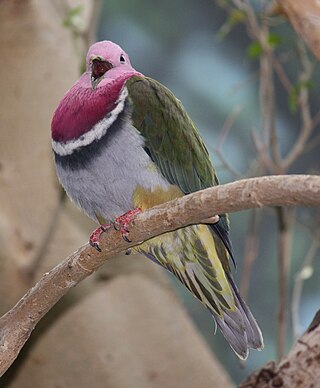
The pink-headed fruit dove also known as pink-necked fruit dove or Temminck's fruit pigeon, is a small colourful dove.
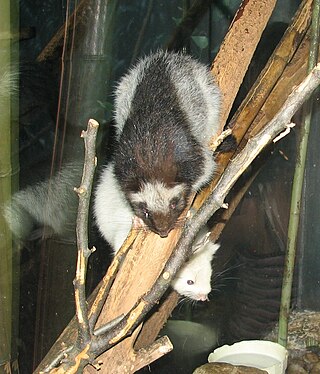
The cloud rats or cloudrunners are a tribe (Phloeomyini) of arboreal and nocturnal herbivorous rodents endemic to the cloud forests of the Philippines. They belong to the family Muridae and include five genera: Batomys, Carpomys, Crateromys, Musseromys, and Phloeomys. They range in size from as large as 50 cm (20 in) to as small as 74 mm (2.9 in). Cloud rats are threatened by habitat loss and illegal hunting. Several species are endangered or critically endangered.

Translocation is the human action of moving an organism from one area and releasing it in another. In terms of wildlife conservation, its objective is to improve the conservation status of the translocated organism or to restore the function and processes of the ecosystem the organism is entering.

The small tree finch is a bird species belonging to the Darwin's finch group within the tanager family Thraupidae. It has a grasping beak with curved culmens. Its natural habitats are subtropical or tropical dry forests and subtropical or tropical dry shrubland. During the non-breeding season it is known to form large groups with small ground-finches.

Urban wildlife is wildlife that can live or thrive in urban/suburban environments or around densely populated human settlements such as townships.

Human–wildlife conflict (HWC) refers to the negative interactions between humans and wild animals, with undesirable consequences both for people and their resources on the one hand, and wildlife and their habitats on the other. HWC, caused by competition for natural resources between human and wildlife, influences human food security and the well-being of both humans and other animals. In many regions, the number of these conflicts has increased in recent decades as a result of human population growth and the transformation of land use.

Wildlife Photographer of the Year is an annual international wildlife photography competition staged by the Natural History Museum in London, England. There is an exhibition of the winning and commended images each year at the museum, which later tours around the world. The event has been described as one of the most prestigious photography competitions in the world.

Chapman's zebra, named after explorer James Chapman, is a subspecies of the plains zebra from southern Africa.
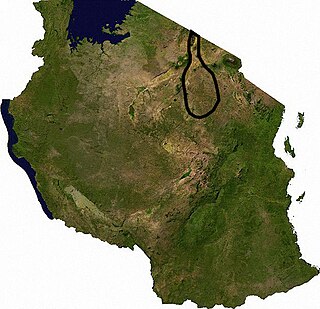
The TarangireEcosystem is a geographical region in northern Tanzania, Africa. It extends between 2.5 and 5.5 degrees south latitudes and between 35.5 and 37 degrees east longitudes.
Laurie Marker is an American zoologist, researcher, author, educator, and one of the world's foremost cheetah experts, who founded the Cheetah Conservation Fund (CCF) in 1990. As executive director of CCF, among many endeavors, Marker helps rehabilitate cheetahs and reintroduce them to the wild, performs research into conservation, biology and ecology, educates groups around the world, and works toward a holistic approach to saving the cheetah and its ecosystems in the wild. Before her work with CCF, Marker's career started to take off at the Wildlife Safari in the U.S., where her interest with captive cheetahs began.
Amelia Jane Dickman is Professor of Wildlife Conservation and Director of WildCRU at the University of Oxford, Kaplan Senior Research Fellow at Pembroke College, Oxford and joint CEO of Lion Landscapes. She is best known for her leadership of the Ruaha Carnivore Project, seeking to improve conservation outcomes for lions and other carnivores in the Ruaha National Park of Tanzania. She is known for her views on the importance of scientific and local community input into discussions around the continued importance of trophy hunting for the conservation of African landscapes.
Ximena Vélez Liendo is a Bolivian conservation biologist whose work focus on the ecology of the Andean bear, known as jukumari in aymara language, and its conservation in Bolivia and the rest of South America.
Bibhab Kumar Talukdar is an Indian conservation biologist. He is the founder of Aaranyak, a leading wildlife non-governmental organization based in Guwahati, India. It is a Scientific, Industrial Research and frontline environmental organization in India.
References
- 1 2 "Our Members". HWCTF.
- 1 2 3 4 5 6 7 8 "Dr Alexandra Zimmermann | Department of Zoology". Zoo.ox.ac.uk. Retrieved 2021-06-18.
- 1 2 3 4 5 6 7 "Alexandra Zimmermann | Senior Advisor, Global Wildlife Program". Blogs.worldbank.org. 2020-11-17. Retrieved 2021-06-18.
- 1 2 "Elephant and tiger attacks highlight India's wildlife conflict - BBC News". BBC News. 12 August 2017. Retrieved 2021-06-18.
- 1 2 "Alexandra Zimmermann - Google Scholar" . Retrieved 2021-06-18.
- ↑ Zimmermann, Alexandra (April 2014). Jaguars and people: A range‐wide analysis of human‐wildlife conflict. (DPhil Thesis) Oxford University.
- 1 2 "World-leading conservationists unite to tackle human-wildlife conflict". Chester Zoo. 2016-10-05. Retrieved 2021-06-18.
- 1 2 "Spectacled bears and snow leopards among creatures getting funding boost". jerseyeveningpost.com. 6 June 2018.
- ↑ "Dr Alexandra Zimmermann | Department of Zoology". Zoo.ox.ac.uk. Retrieved 2021-06-18.
- ↑ "Dr Alexandra Zimmermann". WildCRU. Retrieved 2021-06-18.
- 1 2 "Defra, UK Darwin Initiative". The Darwin Initiative. 2018-07-01. Retrieved 2021-06-18.
- 1 2 IUCN SSC Human-Wildlife Conflict Task Force: 2016-2017 Report
- ↑ "Uomini contro animali, e nessun vincitore / Notizie / Home - Unimondo". www.unimondo.org.
- ↑ "Cash-Strapped Zoos Rethink Financial Strategies - Chinadaily.Com.Cn". Epaper.chinadaily.com.cn. Retrieved 2021-06-18.
- ↑ "Protection de la nature – Ultime bastion pour la faune, les zoos souffrent de la pandémie". Tribune de Genève. 23 October 2020.
- ↑ "Oxford University collaboration wins 'green Oscar' for conservation". WildCRU. 2017-05-18. Retrieved 2021-06-18.
- ↑ "Frontiers in Conservation Science | Human-Wildlife Dynamics". Frontiersin.org. Retrieved 2021-06-18.
- ↑ "Extinction: A million species at risk, so what is saved? - BBC News". BBC News. 28 December 2019. Retrieved 2021-06-18.
- ↑ Gill, Victoria (1970-01-01). "Have rogue orcas really been attacking boats in the Atlantic?". bbc.co.uk. Retrieved 2021-06-18.
- ↑ Helen BriggsBBC Environment correspondent (October 2020). "Covid-19: Funding crisis threatens zoos' vital conservation work - BBC News". BBC News. Retrieved 2021-06-18.
- ↑ "Archived copy". Archived from the original on 2020-11-09. Retrieved 2021-06-18.
{{cite web}}: CS1 maint: archived copy as title (link)